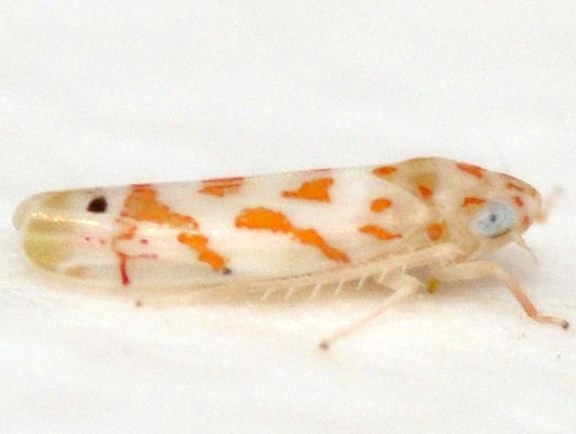| Comment: This page serves as an umbrella for any individuals of Eratoneura that have a similar color pattern to Eratoneura forfex. Eratoneura can be a very challenging genus to identify, as most species are similarly colored and patterned. Eratoneura forfex however, and other species like it, has the broad orange markings near the wing tips touching one another when the wings are closed; the resulting pattern looks like a continuous band in the shape of a W. In other Eratoneura species, this orange 'band' is disconnected, with a noticeable separation between the mark from both wings. Below are the descriptions in the 3I database for E. forfex and the similar E. knullae, and links to images of pinned specimens. As you can see, both species are very similar to one another.
E. forfex- Dorsum yellow or white. Color pattern red or orange. Vertex with orange parallel submedial lines (often with lateral branch). Vertex midline pale. Anteclypeus pale, concolorous with rest of face. Pronotum with Y- or V-shaped medial vitta. Mesonotum pale, with dark lateral triangles, apex concolorous with rest of mesonotum. Thoracic venter entirely pale. Forewings with broken oblique vittae, without crossbands. Clavus with separate basal and distal vittae. Forewings with dark spot on costal margin. Forewing apical cell II without distal spot, inner apical cell with brown spot basally.
E. knullae- Dorsum yellow or white. Color pattern red or orange. Vertex with orange parallel submedial lines (often with lateral branch). Vertex midline pale. Anteclypeus pale, concolorous with rest of face. Pronotum with Y- or V-shaped medial vitta. Mesonotum pale, with dark lateral triangles, apex dark, contrasting with adjacent pale areas. Thoracic venter entirely pale. Forewings with broken oblique vittae, without crossbands. Clavus with separate basal and distal vittae. Forewings with dark spot on costal margin. Forewing apical cell II without distal spot, inner apical cell with brown spot basally.
Additionally, some of the species included in this group could be similar (and perhaps not distinguishable). Eratoneura is a very challenging genus to identify most species to species level. |

 »
»



 »
»

